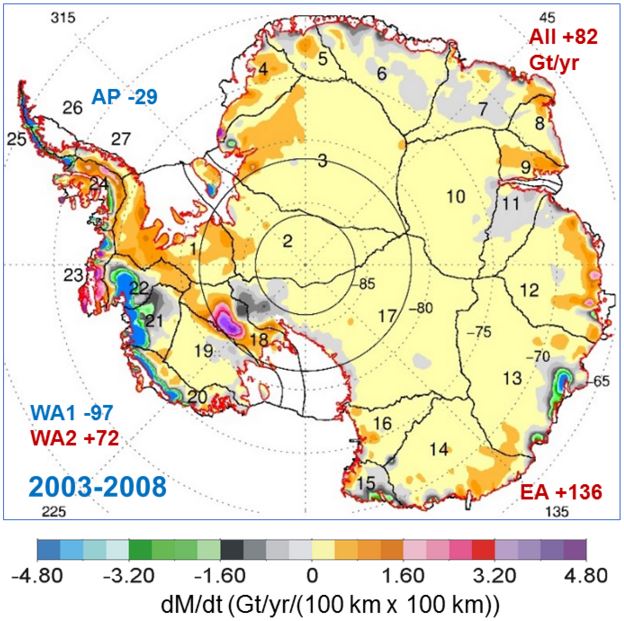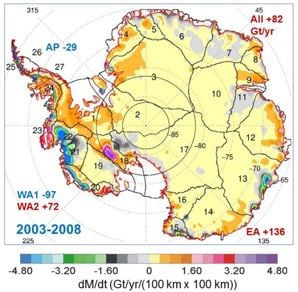After years of gloom and doom warnings by experts that the poles are melting rapidly and sea levels will shoot up, a new NASA study reports that Antarctic ice accumulation that started 10,000 years ago is today adding enough ice to the continent to more than make up for the increased losses from its thinning glaciers – and has been doing this for a long time.
The study contradicts the conclusions of the Intergovernmental Panel on Climate Change’s (IPCC) 2013 report, which warned that Antarctica is overall losing land ice. It challenges several other studies too.
From 1992 to 2001, the Antarctic ice sheet made a net gain of 112 billion tons of ice each year, according to a new analysis of satellite data. From 2003 to 2008 the net gain slowed to to 83 billion tons per year. However, over a 16-year period, the net gain has been considerable.
 Map showing the rates of mass changes from ICESat 2003-2008 over Antarctica. (Image: www.nasa.gov Credits: Jay Zwally/ Journal of Glaciology)
Map showing the rates of mass changes from ICESat 2003-2008 over Antarctica. (Image: www.nasa.gov Credits: Jay Zwally/ Journal of Glaciology)
The scientists published their findings in the Journal of Glaciology.
Ice gains in Antarctica far outweigh losses
Lead author, Jay Zwally, a glaciologist with NASA Goddard Space Flight Center in Greenbelt, Maryland, said:
“We’re essentially in agreement with other studies that show an increase in ice discharge in the Antarctic Peninsula and the Thwaites and Pine Island region of West Antarctica. Our main disagreement is for East Antarctica and the interior of West Antarctica – there, we see an ice gain that exceeds the losses in the other areas.”
“(The team) measured small height changes over large areas, as well as the large changes observed over smaller areas,” Zwally added.
Zwally and colleagues calculated how much the ice sheet is changing (growing/shrinking) from the changes in surface height that are measured by the satellite altimeters.
Where the total amount of now snowfall accumulating on an ice sheet is not the same as the ice flow downward and outward to the ocean, the surface height changes and the ice-sheet mass either shrinks or grows.
 Mass loss in some areas of the continent, like the Antarctic Peninsula photographed above, have increased in the last decades. (Image: www.nasa.gov. Credit: NASA’s Operation IceBridge)
Mass loss in some areas of the continent, like the Antarctic Peninsula photographed above, have increased in the last decades. (Image: www.nasa.gov. Credit: NASA’s Operation IceBridge)
The net gain could reverse one day
However, Zwally warns that it might only take a few decades for the current growth in Antarctica’s ice to reverse and shrink.
Zwally said:
“If the losses of the Antarctic Peninsula and parts of West Antarctica continue to increase at the same rate they’ve been increasing for the last two decades, the losses will catch up with the long-term gain in East Antarctica in 20 or 30 years – I don’t think there will be enough snowfall increase to offset these losses.”
Radar altimeters on two European Space Agency European Remote Sensing (ERS) satellites analyzed changes in surface height of the Antarctic ice sheet from 1992 to 2001, and the laser altimeter on NASA’s Ice, Cloud and land Elevation Satellite (ICESat) did the same from 2003 to 2008.
Zwally pointed out that while other researchers have assumed that the elevation gains observed in East Antarctica are due to recent increases in snow accumulation, he and his team used meteorological data starting in 1979 to show that snowfall in that area actually declined by 11 billion tons per year during both the ERS and ICESat periods.
Thickening has been occurring for a long time
They also used data on snow accumulation for tens of thousands of years, derived by other researchers from ice cores, to conclude that the whole East Antarctica region has been thickening for a very long time.
Zwally said:
“At the end of the last Ice Age, the air became warmer and carried more moisture across the continent, doubling the amount of snow dropped on the ice sheet.”
The extra snowfall that started 10,000 years ago has been gradually accumulating on the ice sheet and compacting into solid ice over thousands of years, thickening the East Antarctica ice and the interior of West Antarctica by an average of 1.7 centimeters (0.7 inches) annually.
This relatively small thickening, sustained over several thousand years and spread over this huge part of Antarctica, corresponds to a very significant ice gain – enough to more than make up for the losses from fast-flowing glaciers in other parts of the continent and reduce global sea level rise.
Zwally and colleagues calculated that the mass gain from East Antarctica’s thickening had remained steady from 1992 to 2008 at 200 billion tons annually, while the ice losses from the West Antarctica coastal regions and the Antarctic Peninsula increased by 65 billion tons annually.
Good and bad news
Zwally said:
“The good news is that Antarctica is not currently contributing to sea level rise, but is taking 0.23 millimeters per year away. But this is also bad news. If the 0.27 millimeters per year of sea level rise attributed to Antarctica in the IPCC report is not really coming from Antarctica, there must be some other contribution to sea level rise that is not accounted for.”
Ben Smith, a glaciologist with the University of Washington in Seattle, who was not involved in this study, said:
“The new study highlights the difficulties of measuring the small changes in ice height happening in East Antarctica.”
“Doing altimetry accurately for very large areas is extraordinarily difficult, and there are measurements of snow accumulation that need to be done independently to understand what’s happening in these places.”
NASA is developing ICESat-2, the successor to ICESat, to help accurately measure changes in the continent. It is scheduled to launch in 2018.
Tom Neumann, a glaciologist at Goddard and deputy project scientist for ICESat-2, said:
“ICESat-2 will measure changes in the ice sheet within the thickness of a No. 2 pencil. It will contribute to solving the problem of Antarctica’s mass balance by providing a long-term record of elevation changes.”
Chinese and Australian scientists have signed a Memorandum of Understanding. They will now share their knowledge and research on Antarctic sea ice in order to create better forecasting models, which they hope will help ships better navigate in the Antarctic region.
Citation: “Mass gains of the Antarctic ice sheet exceed losses,” Zwally, H. Jay; Li, Jun; Robbins, John W.; Saba, Jack L.; Yi, Donghui3; Brenner, Anita C. Journal of Glaciology. October 29, 2015. DOI: http://dx.doi.org/10.3189/2015JoG15J071.
Video – Ice net gain in Antarctica

